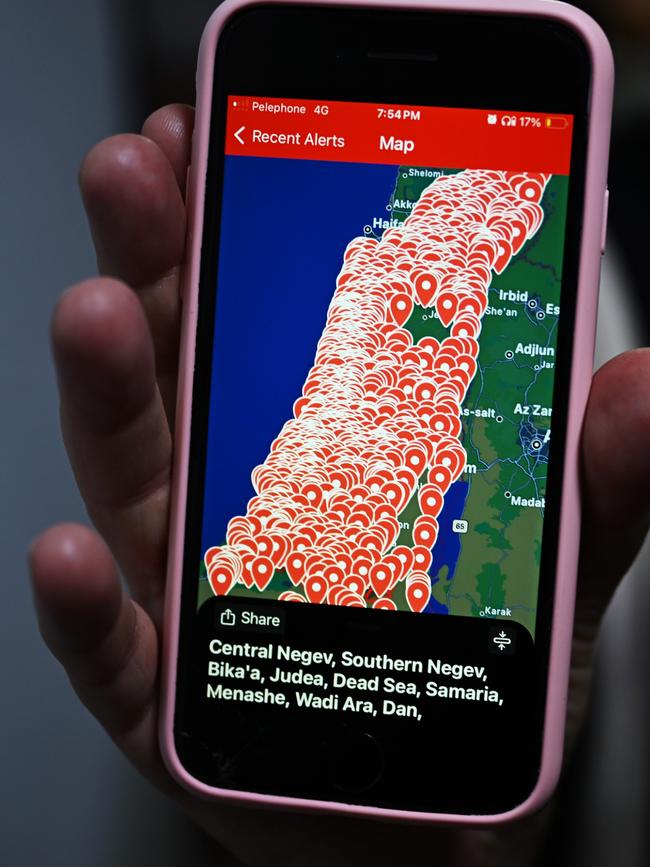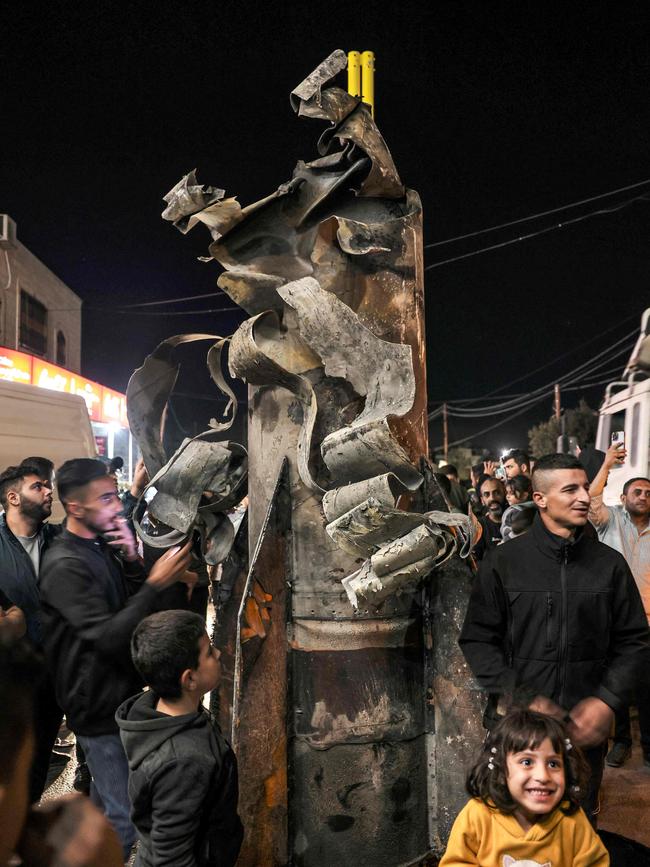The conflict in the Middle East has suddenly escalated, with Iran launching 180 missiles into Israeli airspace, and Israel threatening swift retaliation.
While most of the 180 projectiles were intercepted by Israeli defence systems and just one fatality has been recorded (a Palestinian man in the West Bank), Israeli Prime Minister Bejamin Netanyahu warned that Tehran had made “a big mistake tonight, and will pay for it”.
“Iran doesn’t understand our determination to retaliate against our enemies,” he said.
Iranian President Mahmoud Pezeshkian has issued a warning of his own, posting on X: “Let Netanyahu know that Iran is not belligerent, but it stands firmly against any threat. This is only a corner of our power. Do not enter into a conflict with Iran.”
The missile blitz marks the second time Iran has directly attacked Israel in the year since the Gaza conflict ignited on October 7 last year. In April the Islamic Revolutionary Guards sent about 300 projectiles into Iran, most of which were also intercepted by Israel’s Iron Shield defence system.
Ian Parmeter, a researcher at the Centre for Arab and Islamic Studies at the ANU, said there were reasons why Iran did not a wider war.
“Iran has in mind that if a war got out of hand, it could actually provide an excuse for Israel and the United States to attack Iran’s nuclear facilities,” he said.
“Basically that would be a major assault on Iran, and Iran has always seen Hezbollah and its 150,000 projectiles of various sorts as an insurance policy against that.”
But he also added a strong caveat.
“What I’ve found in 40 years of working on Middle East issues is that logic I would think compelling is not always as compelling to operatives and people on the ground,” he said.
Iran can strike deep and is a major threat to Israel, ranked as the 14th strong military country in the world by Global Firepower.
It possesses nine devastating missiles that can strike as far as 2500km away in Turkey or Egypt.
It's the Sejjil missile however, which is the one that would have Israelis most on edge as it has a range of 2000-2500km and can be fired at four or five times the speed of sound.
Iran said its missile strikes this week were in response to Israel’s killing of Hezbollah leader Hassan Nasrallah last week.
Israel has been bombing targets in Lebanon over the past week and its Security Cabinet approved a ground invasion late on Monday night local time.
Tanks are positioned at Israel’s border with Lebanon and Israeli troops are conducting ground operations targeting close-range Hezbollah infrastructure.
Meanwhile, the US has sent thousands of troops to the Middle East and doubled its air power in the region.
Israeli air strikes have killed more than 1200 people and wounded thousands more, according to Lebanon’s Health Ministry, as global leaders accuse Israel of provoking all-out war.
Hezbollah has 100,000 fighters, while Israel has 170,000 including 465,000 reserves.


Hezbollah has been dealt a series of devastating blows, including the deaths and injuries of many operatives from booby-trapped pagers and walkie-talkies on September 18 and 19, followed by the assassinations of key leaders.
But it’s still a force to be reckoned with.
It has pounded northern Israel with rockets, targeting both civilian and military targets, prompting the IDF to move thousands of troops to defend its northern border.


Hezbollah medium-range rockets have landed as far as the northern tip of the West Bank, about 200 kilometres from the Lebanese border.
Those missiles targeted sites such as the Ramat David air base, Israel’s northernmost military base with fighter jets, unmanned aerial vehicles and helicopters based there.
Israel, however, has far outnumbered Hezbollah when it comes to these strikes and therefore, inflicted the most damage.
Hezbollah has suffered a massive series of blows with Israeli air strikes targeting the group’s leadership. First was senior commander Ibrahim Aqil, killed an astonishing 520km from the Lebanese border, but the big scalp came on Friday, when an Israeli missile strike on Beirut took out the leader Hassan Nasrallah.
Other missiles have targeted Hezbollah rocket launchers, weapon storage facilities and associated infrastructure.
But military analysts warned Hezbollah could quickly regroup and strike deep into Israel with its military arsenal of 120,000-200,000 missiles.
The smallest of its range of rockets is the Katyusha – a type of artillery first built and fielded by the Soviet Union in World War II. It has a range of anywhere between 4-40km.
The Fajr-5 is one of Hezbollah’s mid-range rockets. The Iranian 333-caliber missile developed during the 1990s and exported to various armed forces in the Middle East has a range of 75km.
If Hezbollah wanted to inflict maximum damage further afield, it can choose from its long range rockets: the Zeizal-2 (a range of 210km); Fateh-110 (250-300km) and Scud-B/C/D (300-500km).
Hezbollah’s extensive arsenal also includes aircraft, unmanned planes, tanks and cannons.
Sounds impressive, but remember, Hezbollah and Iran are up against one of the most militarily strong countries in the world and it’s going to take a lot to out-weapon them.
Israel is ranked in the top 20 of strong military countries in the world by Global Firepower, and is equipped with F-16 fighter jets – the American single-engine supersonic multi-role fighter aircraft.
They’ve also got the Iron Dome which can shoot down enemy rockets out of the sky.
Israel has 601 military aircraft, 2200 tanks, 300 multiple rocket launch systems and 67 naval vessels.
If Israel pursues a ground war against Hezbollah, it possesses the Merkava IV tank, widely referred to as one of the best armoured vehicles in the world. It can fire various 120mm ammunition types and is equipped with machine guns and 60mm mortar.
Four soldiers operate this tank, which is perfect for intercepting anti-tank missiles and rocket-propelled grenades.
The vehicles are equipped with IronVision helmets, which provide a real-time, high-resolution, full-colour feed of the tank’s surroundings.
Hezbollah will also be up against it if they encounter the Namer tank, dubbed the heaviest and best-protected armoured personal carrier in the world.
Hezbollah leader Hassan Nasrallah was the number one target for Israel.
He joined Hezbollah after the 1982 Israeli invasion of Lebanon and became leader after the previous leader, Musawi, was assassinated in 1992.
Under Nasrallah, Hezbollah had acquired rockets with a longer range, allowing them to strike at northern Israel.
He’d ordered all attacks since October last year, but particularly after Israeli detonated booby-trapped pagers and walkie-talkies in Lebanon earlier in September, a move which Nasrallah said “crossed the red line”.
Analysts believe further escalation of the conflict will depend on Iran, which has been funding Hamas, Hezbollah, and the Houthis for decades.
“Iran would be the one to instigate an all-out war, given they have a very strong control over Hezbollah,” Ian Parmeter from ANU said.
“Israel and Hezbollah are still not using all of the force at their disposal. If Hezbollah were to start using the 150,000 missiles, rockets and drones it has as its disposal, it could be firing up to 3000 projectiles in the direction of Israel per day. If they sent a barrage like that it would be very difficult for the Iron Dome system.”
In an interview ahead of his UN General Assembly speech, Iranian president Masoud Pezeshkian called on the world not to allow Lebanon to “become another Gaza” and said Hezbollah “cannot stand alone” against Israel.
Iran has built a network of proxies across the Middle East, even beyond Hamas, Hezbollah, and the Houthis, which has drastically disrupted shipping in the Red Sea corridor.
Islamic Jihad has received weaponry and other matériel from Tehran, while Iraqi militias Asa’ib Ahl al-Haq, Kata’ib Hezbollah and Badr Organisation are also reportedly ready to attack Israel on command.

Add your comment to this story
To join the conversation, please log in. Don't have an account? Register
Join the conversation, you are commenting as Logout
Harry reveals King won’t speak to him in bombshell interview
In a new interview, Prince Harry has issued a desperate plea to the royals after losing his appeal against the UK government as Buckingham Palace breaks its silence. See the video.
Adorable new photo of Princess Charlotte released
The Prince and Princess of Wales have unveiled a new image of Princess Charlotte to mark the young royal’s tenth birthday.